by Bruce Wells | Sep 29, 2023 | Petroleum Pioneers
Post-Civil War oilfield discoveries launch Allegheny petroleum boom in Pennsylvania.
Soon after the Civil War ended and demand for kerosene lamp fuel soared, the rapidly growing U.S. petroleum industry discovered oilfields west of Tidioute, Pennsylvania. Wooden derricks replaced trees on Triumph Hill.
Formerly quiet Pennsylvania hillsides of hemlock woods vanished in early October 1866 when oil fever came to Triumph Hill. The U.S. oil industry was barely seven years old. About 15 miles east of the 1859 first American oil well at Titusville, an 1866 oil discovery at Triumph Hill sparked a rush of uncontrolled development.
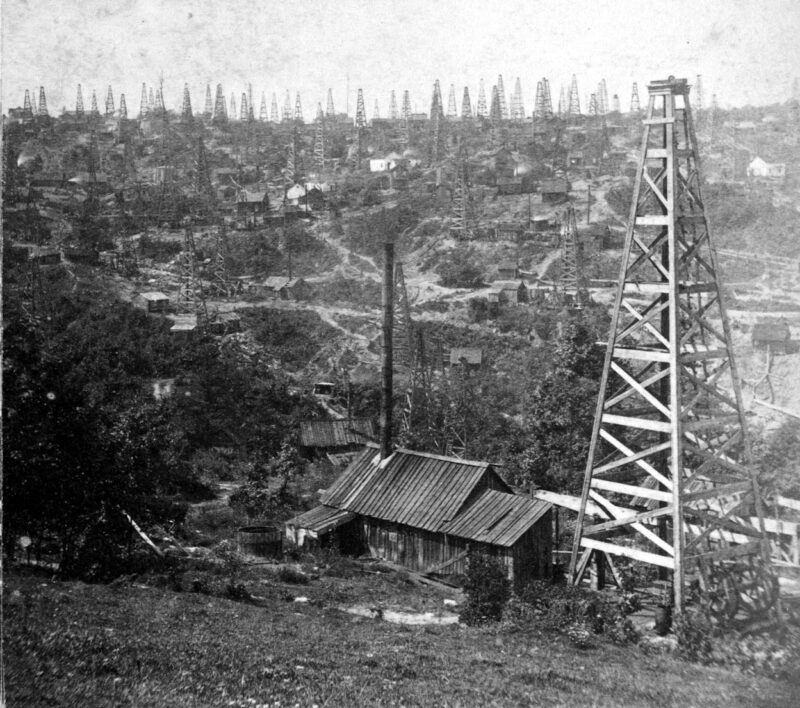
An 1870s photograph of the east side of Triumph Hill, near Tidioute, Pennsylvania, by Frank Robbins of Oil City. Image is right half of a stereo card rendered black and white for clarity from original sepia tone. Photo courtesy Biblioteca Nacional Digital Brazil.
The oil drilling craze would not last long, but boom towns sprang up at Gordon Run and Daniels Run west of Tidioute on Pennsylvania’s Allegheny River.

Like the earlier discoveries at Titusville, Rouseville, and Pithole, hillside trees were turned into derricks and oil storage tanks as drilling intensified. News about a deadly Rouseville oil well fire in April 1861 had been overshadowed by the Civil War.
The excitement at Tidioute (pronounced tiddy-oot) was joined by the roughneck-filled towns of Triumph and Babylon, where “sports, strumpets and plug-uglies, who stole, gambled, caroused and did their best to break all the commandments at once.”
Fresh from the oilfields at booming Pithole 25 miles to the southwest, the infamous Ben Hogan, self proclaimed “Wickedest Man in the World,” operated a bawdy house on the Triumph hillside along the Allegheny River.
Latest Pennsylvania Oil Boom
Despite growing recognition that crowded drilling reduced reservoir pressures and production, the exploration and production bonanza, which began with the first well on October 4, 1866, prompted a frenzy of drilling as investors tried to cash in before the oil ran out.
By the summer of 1867, Triumph Hill was producing 2,000 barrels of oil a day. The flood of oil bought lower prices — an early example of the petroleum industry’s boom and bust cycles.
Photographer Frank Robbins of Oil City published stereographic images of Triumph Hill, declaring it to be “the most magnificent oil belt (as oil men call a strip of producing land) ever yet discovered.”
He added, “On this belt which is but two miles long, and less than one mile wide — were over 180 producing wells, nearly every one of which was in operation at once.”

Robbins, who moved his studio to Bradford 1879 when that region was on its way to becoming “America’s first billion dollar oilfield,” also printed postcards for sale to tourists.

An image from the 1903 edition of “Sketches in Crude-Oil; some accidents and incidents of the petroleum development in all parts of the globe” by James McLaurin.
“Triumph Hill turned out as much money to the acre as any spot in Oildom,” noted James McLaurin in his 1896 book Sketches in Crude-Oil (some accidents and incidents of the petroleum development in all parts of the globe).
Many of the hill’s wells averaged 25 barrels of oil a day, McLaurin reported, adding that “the sand was the thickest – often ninety to one hundred and ten feet – and the purest the oil region afforded.” Eventually the tempo of oil exploration around Tidioute and boom town debauchery slowed as the region’s daily production fell.
Drilling discipline and well spacing, reservoir engineering and other oilfield management skills would evolve, but Triumph Hill’s glory dissipated within five years as overproduction drained the field.
Today, Triumph Hill remains as one of the many quietly beautiful and forest-covered sites along the Allegheny River Valley that has earned a special place in America’s petroleum history.
Tidioute also is among the earliest panoramic maps of America’s petroleum communities. The view was created by Thaddeus Mortimer Fowler, a popular “bird’s-eye view” cartographer. Learn more about Fowler and his maps in Oil Town “Aero Views.”

Traveling from Pennsylvania to Texas at the turn of the century, Thaddeus Mortimer Fowler created oil town “aero views” – panoramic maps of many of America’s earliest petroleum communities. Courtesy Library of Congress Prints and Photographs Division.
Early Oilfield Photography
Pioneer petroleum industry photographers like “Oil Creek Artist” John A. Mather documented Northwestern Pennsylvania boom towns. He and others like Frank Robbins captured views of North American oil booms, according to geologist and historian Jeff Spencer, noting, “Common scenes included oil gushers, oilfield fires, teamsters, and boom towns.”

“Frank Robbins documented the emerging Pennsylvania petroleum industry of the 1860s through 1880s,” Spencer noted in a 2011 article in the journal Oil-Industry History.
“He was one of the most prolific producers of stereoscopic views of oilfields in the Oil City and Bradford, Pennsylvania and Olean, New York area. His many oilfield views include scenes of Triumph Hill, Tidioute, Petrolia, and Pithole,” Spencer noted, adding that many Robbins photographs were used in early postcards.
Spencer featured many historic Texas oilfield postcards in a 2003 book (see Postcards from the Texas Oil Patch).
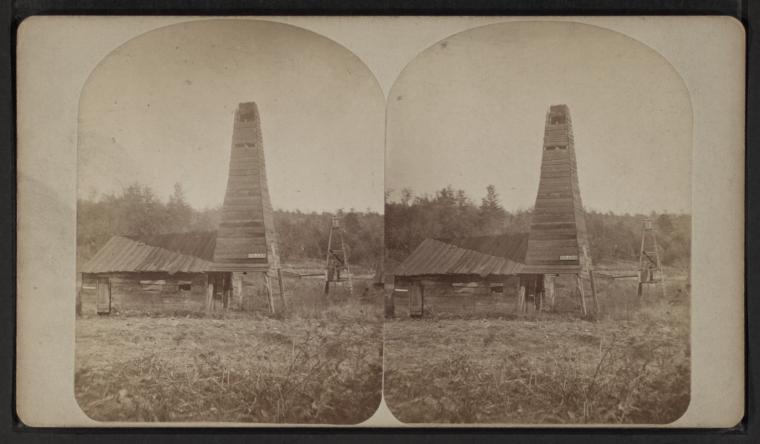
A stereoscopic view by Frank Robbins described simply as “Drake Well, the first oil well.” Courtesy the New York Public Library
For more resources of oilfield imagery, visit the American Oil & Gas Historical Society’s petroleum photography websites.
_______________________
Recommended Reading: Cherry Run Valley: Plumer, Pithole, and Oil City, Pennsylvania, Images of America (2000); Around Titusville, Pa., Images of America
(2000); Around Titusville, Pa., Images of America (2004); Myth, Legend, Reality: Edwin Laurentine Drake and the Early Oil Industry
(2004); Myth, Legend, Reality: Edwin Laurentine Drake and the Early Oil Industry (2009). Your Amazon purchase benefits the American Oil & Gas Historical Society. As an Amazon Associate, AOGHS earns a commission from qualifying purchases.
(2009). Your Amazon purchase benefits the American Oil & Gas Historical Society. As an Amazon Associate, AOGHS earns a commission from qualifying purchases.
_______________________
The American Oil & Gas Historical Society (AOGHS) preserves U.S. petroleum history. Become an AOGHS annual supporting member and help maintain this energy education website and expand historical research. For more information, contact bawells@aoghs.org. Copyright © 2023 Bruce A. Wells. All rights reserved.
Citation Information – Article Title: “Derricks of Triumph Hill.” Authors: B.A. Wells and K.L. Wells. Website Name: American Oil & Gas Historical Society. URL: https://aoghs.org/petroleum-pioneers/triumph-hill-oil. Last Updated: September 27, 2023. Original Published Date: July 3, 2015.
by Bruce Wells | Sep 29, 2023 | Petroleum Pioneers
Giant Mid-Continent oilfield revealed in 1915 by emerging science of petroleum geology.
Community leaders in El Dorado, Kansas, were desperate for their town to live up to its name, especially after big natural gas discoveries at nearby Augusta and at Paola, south of Kansas City. It would be oil, not natural gas, that would do just that when a 1915 well revealed a giant oilfield east of Wichita. In 1918, the El Dorado field would produce almost 29 million barrels of oil.
One-hundred years after the historic discovery, the Butler County Times-Gazette told the prolific oilfield’s “black gold” story.
“In 1915, about 3,000 people called the rural agricultural community of El Dorado home,” the newspaper reported. “They had no idea events toward the end of that year would begin something that would forever change not just El Dorado, but the state and an entire industry.”
Petroleum Geologists
The science of petroleum geology played a key role in discovering the El Dorado oilfield — and many other Mid-Continent fields that followed. Drilled by Wichita Natural Gas, a subsidiary of Cities Service Company, beginning in late September 1915, the October 5 exploratory well revealed a 34-square-mile oilfield.

A marker erected in 1940 at the Stapleton No. 1 well commemorates the October 5, 1915, discovery of the El Dorado, Kansas, oilfield. Photo by Bruce Wells.
The Stapleton No. 1 well produced 95 barrels a day from 600 feet before being deepened to 2,500 feet to produce 110 barrels of oil a day from the Wilcox sands. Discoveries one year earlier in nearby Augusta had prompted El Dorado city fathers to seek a geological study of the area, according to Larry Skelton of the Kansas Geological Survey.

“Pioneers named El Dorado, Kansas, in 1857 for the beauty of the site and the promise of future riches but not until 58 years later was black rather than mythical yellow gold discovered when the Stapleton No. 1 oil well came in on October 5, 1915,” explained Lawrence Skelton in a 1997 USGS Journal article.
By 1914 interest was growing in Butler county and south central Kansas. “A few positive finds had been made, but nothing exciting,” Skelton noted in “Striking It Big in Kansas” for the American Association of Petroleum Geologists (AAPG).
“Henry Doherty, founder of Cities Service in 1910, was seeking new gas reserves and opted for scientific exploration in lieu of wildcatting,” he wrote in the 2002 AAPG Explorer article.
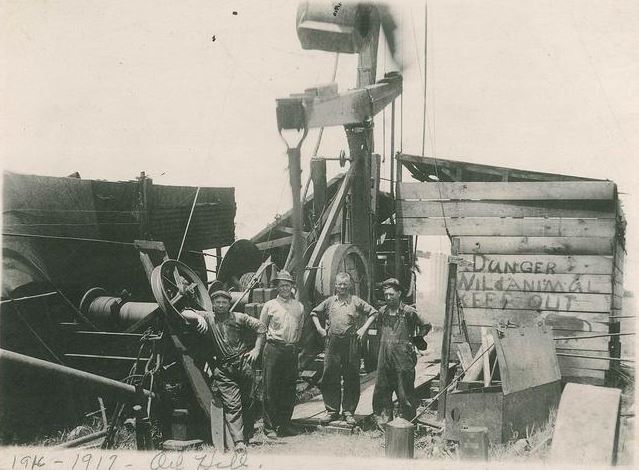
After the 1915 El Dorado oilfield discovery, few companies would drill a well without first seeking the advice of a geologist, Photo courtesy Kansas Oil Museum.
Doherty hired geologists Charles Gould and Everett Carpenter in Oklahoma, sending them to Augusta, in Butler County. Gould had organized the Oklahoma Geological Survey in 1908 and served as its first director until 1911. According to Skelton, the geologists mapped prominent anticlinal structures in Permian Age limestone.
Finding Oil at Anticlines
By late 1914, several Augusta exploratory wells found commercial volumes of natural gas. Several wells also found oil. These developments “chafed El Dorado city fathers.”
According to geologist Skelton, about 15 miles northeast of Augusta, El Dorado had unsuccessfully searched for hydrocarbons since the 1890s. City leaders decided to hire Erasmus Haworth, the state geologist and chairman of the University of Kansas geology department.
“He mapped a large anticline on the same formations used by Gould and Carpenter at Augusta and selected a site that proved to be a dry hole,” Skelton explained.

Undeterred, Cities Service subsidiary Wichita Natural Gas bought the town’s 790 leased acres for $800, verified Haworth’s work and began drilling in late September 1915. The Stapleton No. 1 well found oil within a week.
“Using scientific geological survey methodology for the first time, Cities Service had identified a promising anticline,” Skelton noted. “His field work outlined the El Dorado Anticline.”
Butler County’s geologic revelations encouraged Gulf Oil, Standard Oil, and other companies to acquire leases around Augusta and El Dorado. In addition to Henry Doherty, industry leaders like Archibald Derby, John Vickers and William Skelly established successful El Dorado oil-producing and refining companies.
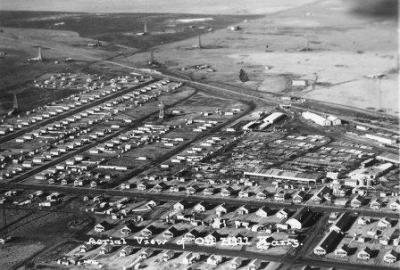
As Butler County wells multiplied, Oil Hill became the largest “company towns” in the world with some 8,500 residents. Photo courtesy Kansas Oil Museum.
“So the idea from that point forward, no oil company in the world would go and drill a well without seeking the advice of a geologist first,” proclaimed the executive director of the Kansas Oil Museum.
“Before 1915, geologists were seen in the same vein as witching and doodlebugs. They were just charlatans,” explained Warren Martin in a 2015 Butler County Times-Gazette article on the centennial of Stapleton No. 1 well.

“It fundamentally transformed it from that point going forward,” Martin added. “Geology was established as one of the great science industries.”
Also see Rocky Beginnings of Petroleum Geology.
Kansas Oil and Gas Boom
With the influx of thousands of workers, even Wichita accommodations were overwhelmed. Butler County’s population, about 23,000 in 1910, nearly doubled in 1920. To house its workers, Empire Gas & Fuel Company (formerly Wichita Natural Gas) built a 64-acre town northwest of El Dorado.
When the United States entered World War I, oil production escalated with the El Dorado field producing almost 29 million barrels of oil in 1918 — about nine percent of the nation’s oil.
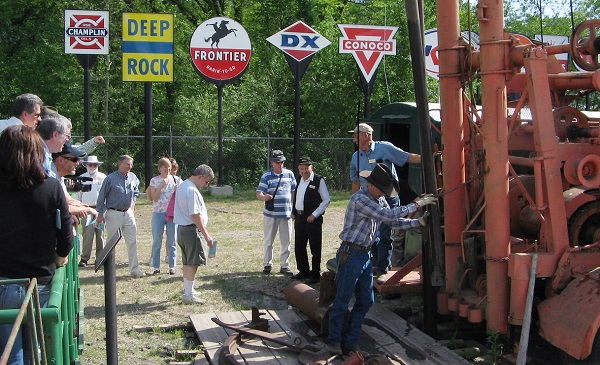
The Kansas Oil Museum includes drilling and production equipment. The museum annually hosts a “Rockfest celebration of geology and oil and gas culture.” Photo by Bruce Wells
Although Oil Hill and its more than 8,000 residents, swimming pool, tennis courts and small golf course would disappear by the late 1950s, at the time it was called the largest “company town” in the world.
The Stapleton No. 1 well, which produced oil until 1967, can be visited by tourists — as can El Dorado’s Kansas Oil Museum, which includes 20 acres of rig displays, equipment exhibits and models of the region’s refinery history. The museum hosts events in an Energy Education Center, offers a variety of K-12 programs, and annually celebrates a “Rockfest” for aspiring geologists.
The Kansas museum’s pumping unit exhibits, the largest one on the grounds, educates visitors about evolving production technologies. It includes a 1970s pumpjack donated by Hawkins Oil Company. Visitors explore a variety of buildings depicting a typical petroleum boom town like Oil Hill.

The state’s earliest oil production began in 1892 at Neodesha in eastern Kansas — the first Kansas oil well — later proclaimed the first commercial discovery west of the Mississippi River.
A natural gas well along the Oklahoma border at Caney, ignited in 1906 and took five weeks to bring under control (see Kansas Gas Well Fire). In far western Kansas, the Hugoton Natural Gas Museum preserves the history of a multistate natural gas geologic formation.
_______________________________________________
The American Oil & Gas Historical Society (AOGHS) preserves U.S. petroleum history. Become an AOGHS annual supporting member and help maintain this energy education website and expand historical research. For more information, contact bawells@aoghs.org. Copyright © 2023 Bruce A. Wells. All rights reserved.
Citation Information – Article Title: “Kansas Oil Boom.” Authors: B.A. Wells and K.L. Wells. Website Name: American Oil & Gas Historical Society. URL: https://aoghs.org/petroleum-pioneers/kansas-oil-boom. Last Updated: September 29, 2023. Original Published Date: October 4, 2015.
by Bruce Wells | Sep 24, 2023 | Petroleum Pioneers
Humble Oil and Refining Company discovered an oilfield in 1943 — earning a $50,000 bounty.
Among its petroleum history records, Florida’s first — but not last — unsuccessful attempt to find commercially viable oil reserves began in 1901, not far from the Gulf Coast panhandle town of Pensacola. Two exploratory wells, the first drilled to a depth of 1,620 feet and the second reaching 100 feet deeper, were abandoned. (more…)
by Bruce Wells | Sep 19, 2023 | Petroleum Pioneers
Pico Canyon oilfield brought pipelines, refineries and Chevron.
After the 1859 first commercial U.S. oil discovery in Pennsylvania, America’s earliest petroleum exploration companies were attracted to California’s natural oil seeps. Small but promising discoveries of “black gold” following the Civil War led to the state’s first gusher in 1876 — and the launching of the California petroleum industry.
Pico Canyon, less than 35 miles north of Los Angeles, produced limited amounts of crude oil as early as 1855, but there was no market for the oil, which was produced near natural oil seeps. The first California oil boom arrived a decade later in the northern part of the state — drilled near seeps.
Humboldt County Oil
Completed in 1865 by the Old Union Matolle Company, the Humboldt County oil well produced near the aptly named Petrolia. The oilfield discovery quickly attracted some of America’s earliest exploration companies.
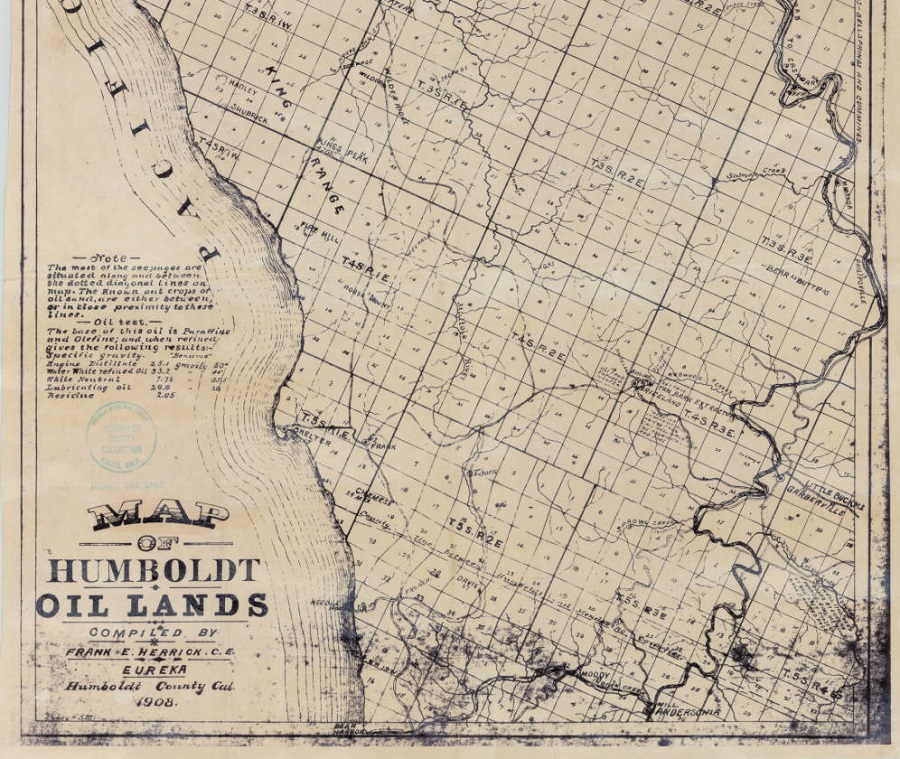
Detail of a 1908 “Map of Humboldt County Oil Lands” includes post-Civil War commercial oil wells that attracted more drilling to northern California. Map courtesy Humboldt County Map Collection, Cal Poly Humboldt Library Special Collection.
A California historical marker (no. 543) dedicated on November 10, 1955 declared:
California’s First Drilled Oil Wells — California’s first drilled oil wells producing crude to be refined and sold commercially were located on the north fork of the River approximately three miles east of here. The Old Union Mattole Oil Company made its first shipment of oil from here in June 1865 to a San Francisco refinery. Many old well heads remain today.

Although the “Old Union well” initially yielded about 30 barrels of high quality oil, production declined to one barrel of oil day and the prospect was abandoned, according to K.R. Aalto, a geologist at Humboldt State University.
The Humboldt County well in what became the oilfield, “attracted interest and investment among oilmen because of the abundance of oil and gas seeps throughout that region,” Aalto noted in his 2011 article in Oil-Industry History. But the California petroleum industry truly began to the south, at Pico Canyon Oilfield, a few miles west of Newhall.
Pico Canyon Well No. 4
In Pico Canyon of the Santa Susana Mountains, Charles Mentry of the California Star Oil Works Company drilled three wells in 1875 and 1876 that showed promise. The first West Coast oil gusher arrived with his fourth well and helped established a major oil company.
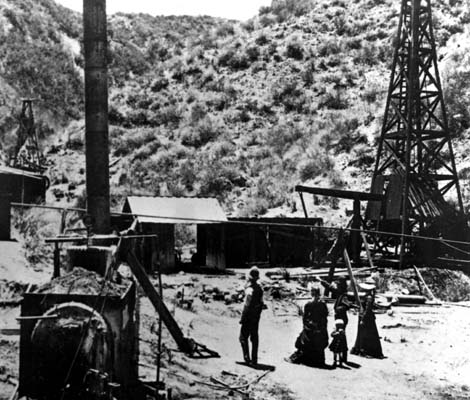
The steam boiler and cable-tools, including the “walking beam,” of Pico Well No. 4 in 1877. Photo by Carleton Watkins courtesy Los Angeles Public Library Photo Collection.
Drilling with a steam-powered cable-tool rig in an area known for its many oil seeps, Mentry discovered the Pico Canyon oilfield north of Los Angeles. California’s first truly commercial oil well, the Pico Well No. 4 gusher of September 26, 1876, prompted more development, including pipeline construction and an oil refinery for producing kerosene.

According to an article in the Los Angeles Times, the well initially produced 25 barrels a day from 370 feet. Mentry improvised many of his cable tools, including making a drill-stem out of old railroad-car axles he welded together.
“The railroad had not then been completed, there was no road into the canyon, water was almost unattainable, and there were no adequate tools or machinery to be had,” noted the Times article.
Newhall Refinery
California Star Oil Works deepened the well to 560 feet, increasing daily production by 125 barrels, and constructed its pipeline from Pico Canyon to the newly built refinery in Newhall, just south of Santa Clarita.
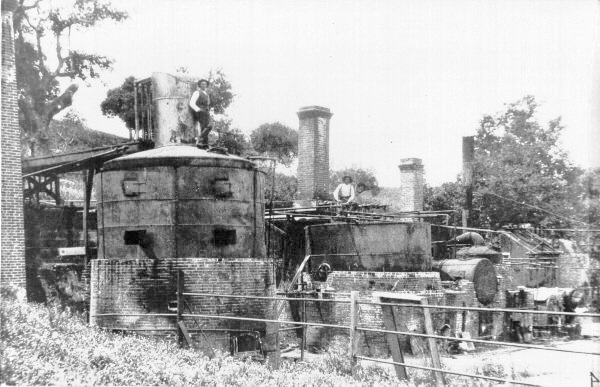
By 1880, California’s first commercial refinery processed oil from its first commercial oil well to make kerosene and other products. Photo courtesy the Santa Clarita Valley Historical Society.
Newhall’s Pioneer Refinery on Pine Street would become the first successful commercial refinery in the West, producing kerosene and lubricants. Giant stills set on brick foundations included two capable of producing 150 barrels a day each. The city of Santa Clarita received California’s first successful refinery as a gift from Chevron in 1997.
The Santa Clarita refinery, today preserved as a tourist attraction, is among the oldest in the world. The major oil company can trace its beginnings to the 1876 Pico Canyon oil well, which has been designated a historic site by the California Office of Historic Preservation.
Birth of Chevron
Chevron, once the Standard Oil Company of California, in 1900 acquired Pacific Coast Oil Company. Pacific Coast had become majority owner of California Star Oil Works in 1879.
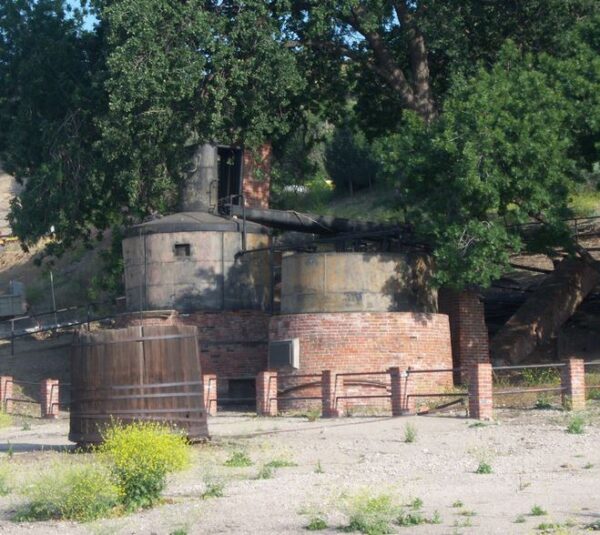
Santa Clarita acquired California’s first refinery as a gift from Chevron in 1997. It is one of the oldest existing oil refinery sites in the world. Photo by Konrad Summers.
Charles Mentry is remembered by a small town a short distance from the 1876 Pico Canyon discovery well, Mentryville. Visit the Santa Clarita Valley Historical Society website to learn more history about Pico Canyon oil production. About 35 miles south of Pico Canyon, a gold prospector discovered the massive Los Angeles field in 1892.
Learn more in Discovering Los Angeles Oilfields.
Refining Kerosene for Lamps
California’s commercial refineries were among the first in America, where the industry began with small refineries in Pittsburgh, Pennsylvania, producing kerosene for lamps. The oil came from Titusville area oilfields — and a giant 1871 field discovered at Bradford, about 70 miles to the northeast.

The Bradford oilfield, which became known as America’s “first billion dollar oil field,” remains home to the American Refining Group. The historic field’s first well produced just 10 barrels a day from 1,110 feet.
By 1875. Bradford leases reached as high as $1,000 per acre. A decade later, a sudden decline in the oilfield’s production led to a technological breakthrough. Pioneers in the new science of petroleum geology suggested that water pressure on oil sands could be used to increase oil production — “waterflooding” the geologic formation.
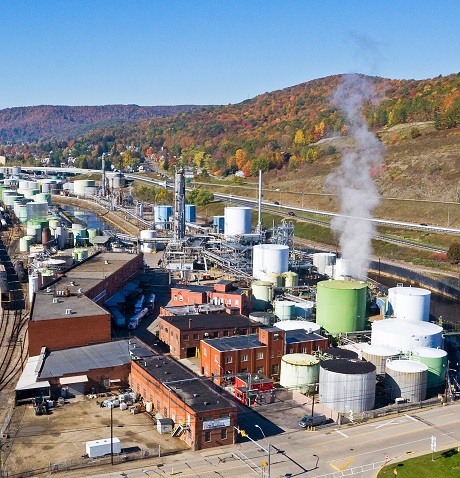
The oldest operating U.S. oil refinery began in 1881 in Bradford, Pennsylvania.
In Neodesha, Kansas, the Norman No. 1 well of 1892 well revealed a petroleum-rich geologic region that would extend across Oklahoma, Texas and Louisiana. Standard Oil built a refinery in Neodesha in 1897 that refined 500 barrels of oil a day. Standard was the first to process oil from the giant Mid-Continent field (learn more in Kansas Well reveals Mid-Continent).
As of January 1, 2022, there were 130 operable petroleum refineries in the United States, according to the Energy Information Administration (EIA), down from 141 refineries in 2017.
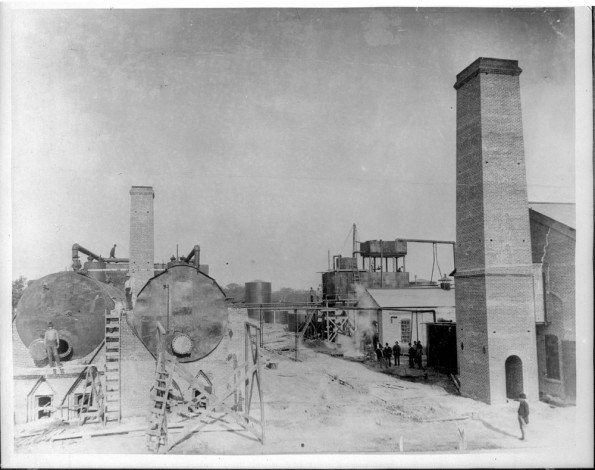
Built in 1897, a Standard Oil refinery in Neodesha, Kansas, refined 500 barrels of oil per day – the first to process oil from the Mid-Continent field. From “Kansas Memory” collection of the Kansas Historical Society.
For an investigation into which California oil well was the first, see this 2011 SearchReSearch blog of Dan Russell.

Learn more California petroleum history in the Signal Hill Oil Boom.
_______________________
Recommended Reading: California State University, Dominguez Hills (2010); Pico Canyon Chronicles: The Story of California’s Pioneer Oil Field
(2010); Pico Canyon Chronicles: The Story of California’s Pioneer Oil Field (1985). Your Amazon purchase benefits the American Oil & Gas Historical Society. As an Amazon Associate, AOGHS earns a commission from qualifying purchases.
(1985). Your Amazon purchase benefits the American Oil & Gas Historical Society. As an Amazon Associate, AOGHS earns a commission from qualifying purchases.
_______________________
The American Oil & Gas Historical Society (AOGHS) preserves U.S. petroleum history. Become an AOGHS annual supporting member and help maintain this energy education website and expand historical research. For more information, contact bawells@aoghs.org. Copyright © 2023 Bruce A. Wells. All rights reserved.
Citation Information: Article Title: “First California Oil Well.” Authors: B.A. Wells and K.L. Wells. Website Name: American Oil & Gas Historical Society. URL: https://aoghs.org/petroleum-pioneers/first-california-oil-well. Last Updated: September 19, 2023. Original Published Date: September 9, 2015.
by Bruce Wells | Sep 15, 2023 | Petroleum Pioneers
Acadia Parish oil seeps inspired 1901 Jennings oilfield discovery.
The first Louisiana oil well in 1901 revealed the giant Jennings field and launched the Pelican State’s petroleum industry. By 1911, offshore exploration included barges, floating pile drivers, and drilling platforms on Caddo Lake.
Nine months after the 1901 “Lucas Gusher” at Spindletop, Texas, oil erupted 90 miles to the east in Louisiana. W. Scott Heywood — already a successful wildcatter at Spindletop — drilled the discovery well of the Jennings oilfield. His September 21, 1901, gusher initially produced 7,000 barrels of oil a day.
Louisiana’s first commercial oil well was completed on the Jules Clements farm, about seven miles northeast of the small town of Jennings.

Mrs. Scott Heywood, “the widow of Louisiana’s oil discoverer, the late W. Scott Heywood,” unveiled an historical marker on September 23, 1951, as part of the Louisiana Golden Oil Jubilee. Times Picayune (New Orleans) image courtesy Calcasieu Parish Public Library.
Local investors earlier had formed the Jennings Oil Company and hired Scott, who recognized that natural gas seeps found nearby were nearly identical to the conditions observed at Spindletop.

Scott would insist on drilling deeper than many investors thought wise.

The Jennings Oil Company No. 1 well, which discovered the first commercial oilfield in Louisiana on September 21, 1901. Photo courtesy Louisiana Geological Survey.
“At the age 29, W. Scott Haywood was already a seasoned, experienced and successful explorer,” noted Scott Smiley, a Louisiana Geological Survey (LGS) historian. “He had gone to Alaska in 1897 during the great Yukon gold rush, sinking a shaft and mining a profitable gold deposit.”
Haywood, who also had drilled several successful oil wells in California, was one of the first to reach Spindletop following news of the January 1901, oilfield discovery. Haywood eventually convinced the reluctant Clements to allow drilling in the farmer’s Acadia Parish rice field. The Clements farm was at the small, unincorporated community of Evangeline, northeast of Jennings.

W. Scott Heywood discovered Louisiana’s Jennings field.
However, after drilling to 1,000 feet without finding oil or natural gas, the Jennings Oil Company’s investors wanted to abandon the first attempt.

“After all, 1,000 feet had been deep enough to discover the tremendous oil gushers at Spindletop field,” explained Smiley in a 2001 history of the Jennings field. “Instead of drilling two wells to a depth of 1,000 feet each, Heywood persuaded the investors to change the contract to accept a single well drilled to a depth of 1,500 feet.”
More drilling pipe was brought in and the well deepened.
Deeper Drilling Pays Off
Heywood found signs of oil at a depth of 1,700 feet – after some discouraged investors had sold their stock when drilling reached 1,000 feet. By 1,500 feet, shares of the Jennings Oil Company still sold for as little as 25 cents each. Patient investors were rewarded when 7,000 barrels of oil per day suddenly erupted from the well.
“The well flowed sand and oil for seven hours and covered Clement’s rice field with a lake of oil and sand, ruining several acres of rice,” reported the Jennings Daily News.
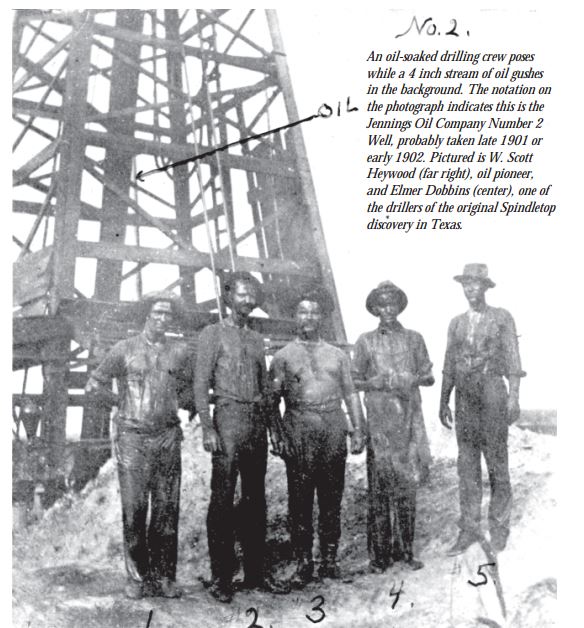
W. Scott Heywood (5) and Elmer Dobbins (3) — “one of the drillers of the original Spindletop discovery in Texas.” Photo courtesy Louisiana Geological Survey.
Although the Jules Clements No. 1 well is on only a 1/32 of an acre lease, it marked the state’s first oil production and launched the Louisiana petroleum industry. It opened the prolific Jennings field, which Heywood developed by securing leases and building pipelines and storage tanks.
The Jennings oilfield reached its peak production of more than nine million barrels in 1906. Meanwhile, an October 1905 discovery in northern Louisiana further expanded the state’s young petroleum industry (visit the Louisiana Oil Museum in aptly named Oil City).

Haywood returned to Alaska in 1908 on a big-game hunting trip. He retraced much of his travels to the Klondike gold fields, notes Smiley. “After a brief retirement in California, he returned to Jennings and drilled several wells at Jennings and elsewhere in Louisiana,” Smiley reports, adding the he also found success at the Borger and Panhandle oilfields in Texas.
“Heywood returned to Jennings in 1927 and assisted Gov. Huey P. Long in passing legislation to provide schoolbooks for children,” concluded the geologist in Jennings Field – The Birthplace of Louisiana’s Oil Industry, September 2001.

Rapid development of the Jennings oilfield in the the early 1900s led to new conservation laws. A lack of spacing regulations forced “each leaseholder to drill their own well to prevent the draining of oil from the lease by an adjacent well.” Circa early 1900s photo courtesy Louisiana Geological Survey.
A retired professor challenged the date of Louisiana’s first commercial oil well during a 2011 presentation at Carnegie Library in Sulphur. Thomas Watson, PhD, “has uncovered evidence that the first producing oil well in Louisiana was at the Sulphur Mines in 1886,” noted the Sulphur Daily News.
“This information could alter the history of oil production in Louisiana,” Watson reported.
Offshore Caddo Lake
Gulf Refining Company in 1911 drilled Ferry Lake No. 1 on Caddo Lake, Louisiana, using a fleet of tugboats, barges, and floating pile drivers. When the first well produced 450 barrels of oil per day, Gulf constructed platforms every 600 feet on each 10-acre lakebed (see Offshore Drilling History).

Along with wells on a lake in Ohio, the Caddo Lake wells have been called the birth of America’s offshore drilling industry. Oil was produced from platforms on Grand Lake St. Marys as early as early as 1887 (see Ohio Offshore Wells).
_______________________
Recommended Reading: Louisiana’s Oil Heritage, Images of America (2012); Early Louisiana and Arkansas Oil: A Photographic History, 1901-1946
(2012); Early Louisiana and Arkansas Oil: A Photographic History, 1901-1946 (1982). Your Amazon purchase benefits the American Oil & Gas Historical Society. As an Amazon Associate, AOGHS earns a commission from qualifying purchases.
(1982). Your Amazon purchase benefits the American Oil & Gas Historical Society. As an Amazon Associate, AOGHS earns a commission from qualifying purchases.
_______________________
The American Oil & Gas Historical Society (AOGHS) preserves U.S. petroleum history. Become an AOGHS annual supporting member and help maintain this energy education website and expand historical research. For more information, contact bawells@aoghs.org. Copyright © 2023 Bruce A. Wells. All rights reserved.
Citation Information – Article Title: “First Louisiana Oil Well.” Authors: B.A. Wells and K.L. Wells. Website Name: American Oil & Gas Historical Society. URL: https://aoghs.org/petroleum-pioneers/first-louisiana-oil-well. Last Updated: September 16, 2023. Original Published Date: September 1, 2005.
by Bruce Wells | Sep 12, 2023 | Petroleum Pioneers
Persistence and deeper wells launched Utah’s petroleum industry in 1948.
After decades of expensive failed exploration attempts (and a few small producers), the first significant Utah oil well was competed on September 18, 1948, in the Uinta Basin. The Ashley Valley No. 1 well, about 10 miles southeast of Vernal, produced about 300 barrels a day from a depth of 4,152 feet.
“The honor of bringing in the state’s first commercial oil well went not to the ‘Majors’ but to an ‘Independent’ — the Equity Oil Company,” noted a Utah historian.

The Uinta Basin witnessed Utah’s first drilling boom following a 1948 oil discovery. A modern boom would return thanks to coalbed methane gas. Photo courtesy Utah State Historical Society.
(more…)




(2000); Around Titusville, Pa., Images of America
(2004); Myth, Legend, Reality: Edwin Laurentine Drake and the Early Oil Industry
(2009). Your Amazon purchase benefits the American Oil & Gas Historical Society. As an Amazon Associate, AOGHS earns a commission from qualifying purchases.


















